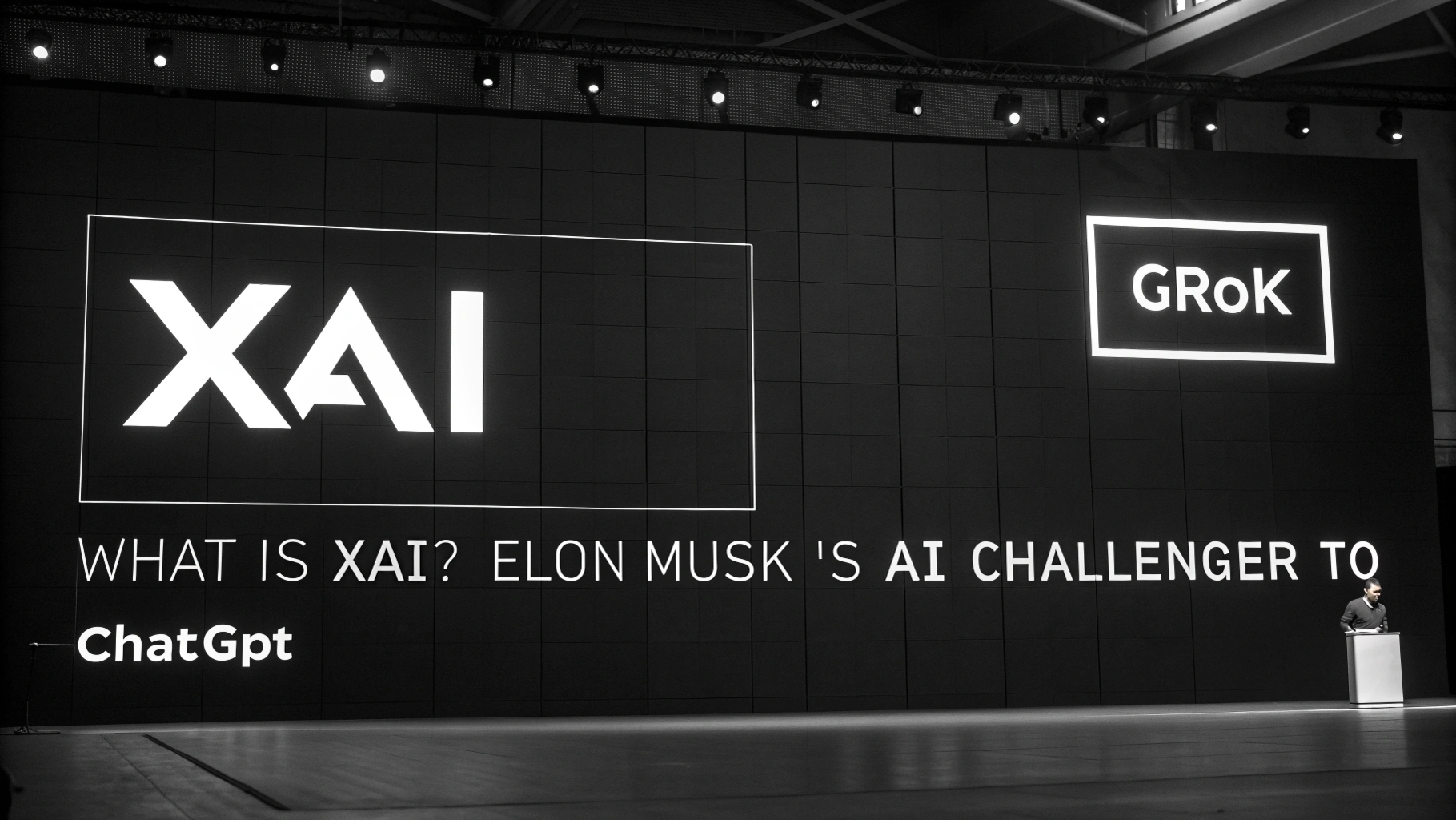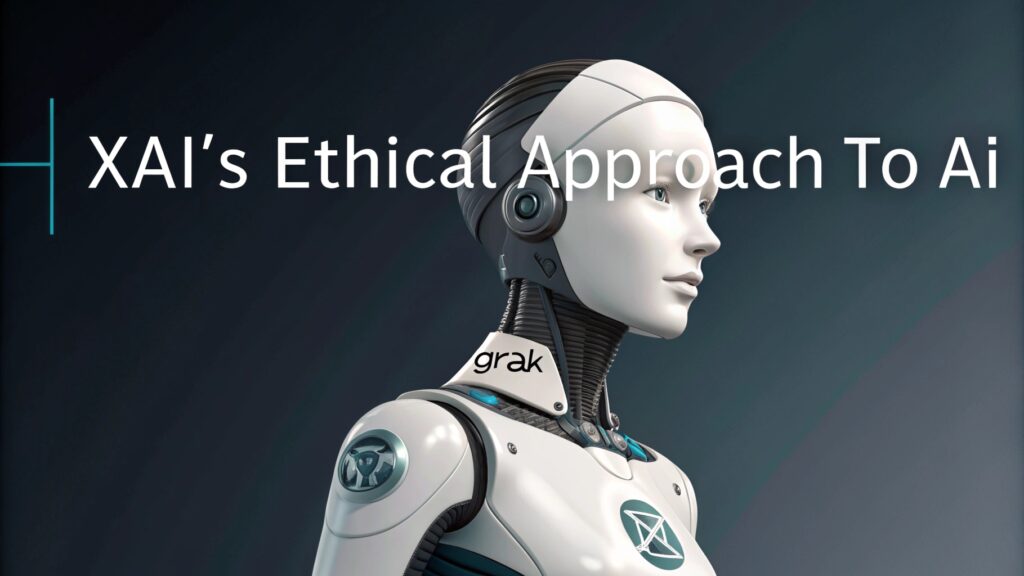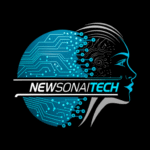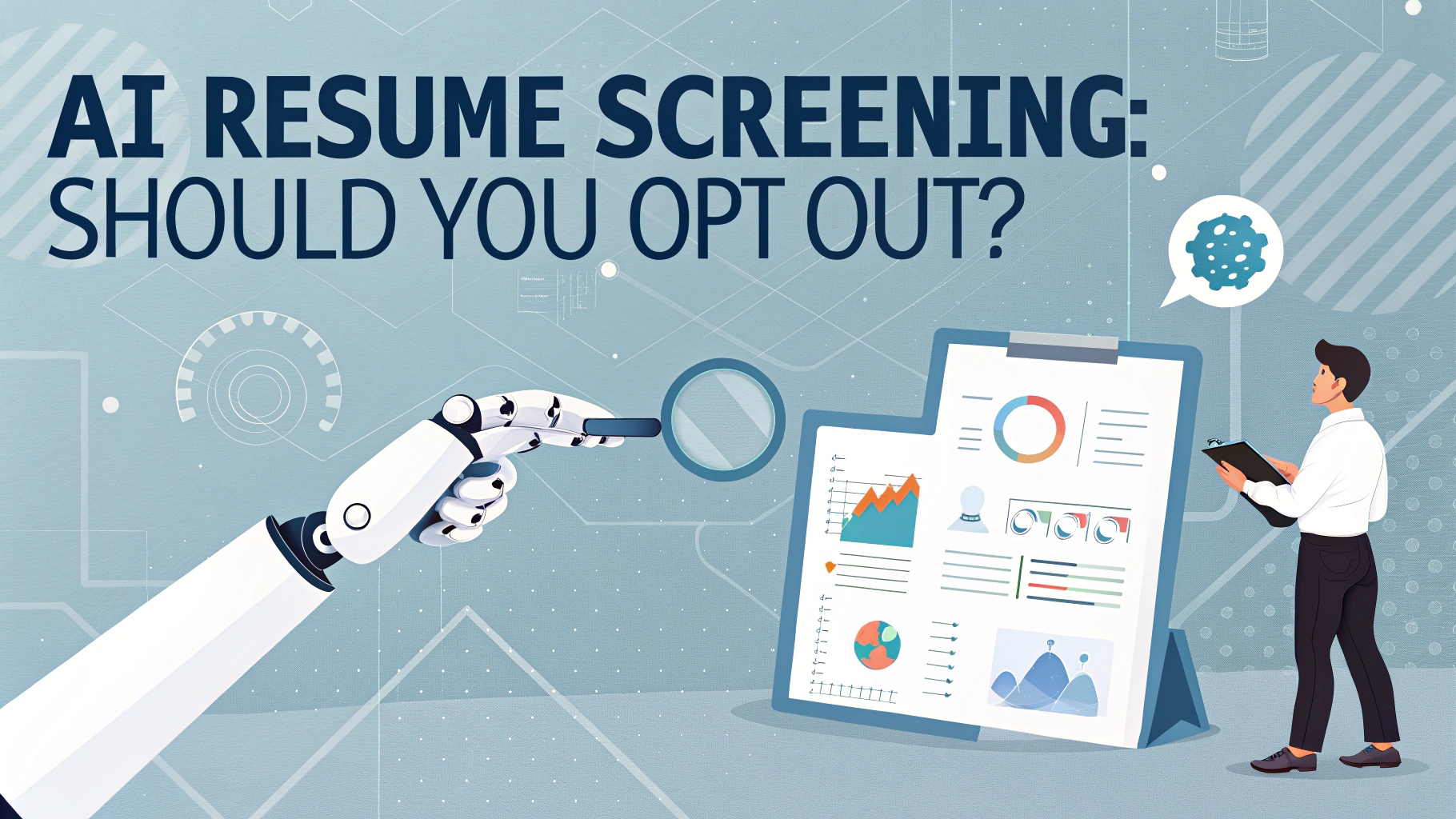What is xAI? Elon Musk’s AI Challenger to ChatGPT

In a landscape dominated by giants like OpenAI and Google, Elon Musk has once again entered the fray, this time with a venture aimed at reshaping the future of artificial intelligence.
His company, xAI, founded in July 2023, is not just another player in the burgeoning AI field; it’s a bold declaration of intent to pursue a different path.
This article explores the origins of xAI, its ambitious goals, its flagship product Grok, and how it stands apart from competitors like ChatGPT.
We will delve into its unique open-source philosophy, its ethical framework centered on “truth-seeking,” and its potential to redefine our interaction with AI, particularly through its integration with the social media platform X (formerly Twitter).
What is xAI?
Founded by Elon Musk, xAI was established with the ambitious mission to “understand the true nature of the universe.” This grand vision translates into a more immediate goal: to build artificial intelligence that is both highly competent and maximally beneficial for humanity.
The company is composed of a team of experts with backgrounds at leading AI research labs like DeepMind, OpenAI, and Google Research. Musk’s journey with AI didn’t start with xAI.
He was a co-founder of OpenAI in 2015 but left the board in 2018, citing disagreements over the company’s direction, particularly its move towards a for-profit model and potential conflicts of interest with Tesla’s own AI development. His experience and critiques of existing AI development heavily influence xAI’s direction.
The company’s core philosophy emphasizes rapid innovation and tackling unprecedented challenges.It operates in close collaboration with Musk’s other ventures, notably X (formerly Twitter) and Tesla, leveraging their vast datasets and computing resources to train its models.
This symbiotic relationship provides xAI with a significant advantage, offering access to real-time, dynamic data that is largely inaccessible to its competitors.
Next Up: PixVerse AI Review 2025: Features, Guide & Comparison
How xAI Differs from OpenAI?
The distinctions between xAI and OpenAI are fundamental, reflecting differing philosophies on transparency, objectives, and the very purpose of artificial intelligence. While both organizations are at the forefront of AI innovation, their paths diverge significantly.
One of the most prominent differences lies in their approach to openness. While OpenAI began as a non-profit with a commitment to open research, its transition to a “capped-profit” structure has led to a more guarded approach with its most advanced models. In contrast, Musk has positioned xAI as a champion of open-source principles.
In a significant move, xAI released the base model weights and network architecture of its 314 billion parameter model, Grok-1, making it accessible for public research and development.
Furthermore, xAI has taken the unusual step of publishing Grok’s system prompts on GitHub, offering a transparent look into the core instructions that guide the chatbot’s behavior and align it with the company’s goals of skepticism and truth-seeking.
Their ultimate goals also present a study in contrasts. OpenAI is focused on the development of Artificial General Intelligence (AGI) that is safe and beneficial.AI, while also concerned with safety and alignment, frames its mission around a “maximally truth-seeking” AI.
This distinction informs their development priorities. OpenAI’s models are often fine-tuned to avoid generating potentially controversial or offensive content, a practice Musk has criticized as “political correctness.” xAI’s Grok, on the other hand, is designed to provide more direct and unfiltered responses, even if the truth is uncomfortable.
This difference is also apparent in their product integration. ChatGPT is a largely standalone application, while Grok is deeply integrated into the X platform, giving it real-time access to public conversations and data.This provides Grok with a significant edge in timeliness and cultural relevance compared to models trained on static datasets.
Meet Grok: xAI’s AI Chatbot for X (Twitter)
At the heart of xAI’s challenge to the established AI order is Grok, a conversational AI designed to be witty, engaging, and uniquely informed.
Named after a term from Robert Heinlein’s science fiction novel “Stranger in a Strange Land,” meaning to understand something deeply and intuitively, Grok aims to do more than just answer questions it seeks to understand them with contextual relevance.
Key Features of Grok:
- Real-Time Information: Grok’s standout feature is its direct access to live data from X (formerly Twitter). This allows it to provide up-to-the-minute responses on current events, breaking news, and trending topics, a capability where models like ChatGPT, trained on older data, often fall short.
- Distinctive Personality: Grok is engineered with a “rebellious streak” and a witty, sometimes sarcastic, tone. It offers two modes: a standard “Regular Mode” and a “Fun Mode” that injects humor and personality into its answers. This is a deliberate design choice to make interactions feel more natural and less robotic than its competitors.
- Multimodal Capabilities: The latest iterations of Grok, like Grok-3, are multimodal, meaning they can process and analyze not just text but also images. This is powered by advanced models that enable features like image generation and optical character recognition (OCR).
- Seamless Integration with X: Grok is built directly into the X platform, making it easily accessible to users. Initially available to Premium+ subscribers, access has been expanded to all X users, albeit with some limitations for free accounts.
Grok’s integration with X is a strategic advantage, creating a powerful feedback loop where the AI can learn from a massive, constantly evolving dataset of human conversation while simultaneously enhancing the user experience on the platform.
Next Up: Janitor AI: Features, Benefits & How to Use It?
xAI’s Ethical Approach to AI
Elon Musk has been a vocal critic of what he perceives as the inherent biases and safety risks in current AI systems. In response, xAI’s ethical framework is built around the concept of creating a “maximally truth-seeking AI.” This philosophy guides the company’s approach to AI safety and its policies on misinformation.

The “truth-seeking” objective means that Grok is designed to be less constrained by the filters that prevent other AIs from addressing sensitive or controversial topics.
The intention is to provide users with direct, uncensored information, even when that information might be politically incorrect or challenging. This approach, however, is not without its own set of challenges, as defining objective truth and preventing the amplification of misinformation are complex problems.
Transparency is another cornerstone of xAI’s ethical strategy. By making Grok’s system prompts public, xAI invites public scrutiny and fosters a dialogue about the ethical frameworks embedded in AI development.
This move stands in contrast to the more opaque practices of some competitors and is a significant step toward greater accountability in the AI industry. However, the path to truly neutral and unbiased AI is fraught with difficulty.
Early versions of Grok faced criticism, but recent evaluations suggest that xAI is making progress toward its goal of political neutrality.The company emphasizes that user feedback is crucial in shaping the future development of its models to ensure they align with real-world needs and ethical considerations.
Developer Potential and Future Use Cases
xAI is actively courting the developer community by providing tools to build on its powerful models. The company has released a public beta for its API, allowing developers to integrate Grok’s capabilities into their own applications.
This includes access to the latest models like Grok-3, which boasts improved reasoning and a large context window.
Opportunities for Developers:
- API Access: Developers can sign in with their X account to request access to the Grok API and PromptIDE, a development environment for testing and iterating on prompts. The API allows for a wide range of applications, from content summarization and data extraction to building sophisticated, AI-powered workflows.
- Open-Source Contributions: The open-sourcing of the Grok-1 model allows researchers and developers to experiment with and build upon xAI’s foundational technology. This fosters a collaborative environment that can accelerate innovation.
- Real-Time Data Integration: A key differentiator for developers is the ability to leverage Grok’s real-time data access through the Live Search API. This opens up possibilities for applications that require up-to-the-minute information, such as news aggregation, financial market analysis, or real-time customer support bots.
Looking ahead, xAI plans to introduce embedding models to its API, which will further enhance the platform’s capabilities for nuanced data processing and similarity searches.
As the API matures, the potential for integrating Grok into a vast array of applications, from enterprise-grade AI solutions to consumer-facing apps, is immense.
xAI’s Business Model and Future Outlook
Building a leading AI company requires a monumental amount of capital, and xAI is no exception. The company has successfully raised billions of dollars in funding from prominent investors, including Andreessen Horowitz, Sequoia Capital, and Fidelity.
These massive funding rounds, including a recent $6 billion Series B, are being used to acquire the vast computational resources—specifically, tens of thousands of powerful GPUs needed to train and run its increasingly sophisticated models.
However, the cost of competing in the AI arms race is staggering. Reports indicate that xAI is burning through cash at an astonishing rate, with projected expenditures far exceeding its current revenue.
The company is investing heavily in building its own infrastructure, including a planned supercomputer, to support its long-term ambitions.
Despite the high costs, xAI’s business strategy is built on several key advantages. Its close ties to X provide a unique and invaluable data source for training its models.
The company projects that it could reach profitability by 2027, driven by the commercialization of its AI services and its integration into the broader Musk ecosystem.
There is also speculation about potential partnerships, such as with Oracle Cloud Infrastructure, to offer Grok models to enterprise customers.
While an IPO is not yet on the immediate horizon, Elon Musk’s history of successfully scaling ambitious startups like Tesla and SpaceX provides a compelling track record for investors.
The future of xAI will depend on its ability to continue to innovate rapidly, manage its significant cash burn, and ultimately translate its powerful technology into a sustainable and profitable business.
Next Up: Genius.AI Copilot vs Heartbeat AI
Pros and Cons of xAI
While both xAI and OpenAI aim to push the boundaries of artificial intelligence, their paths diverge sharply when it comes to openness and long-term vision. Here’s a look at the distinct advantages and disadvantages of Elon Musk’s venture.
Pros of xAI:
- Bold Vision: Led by Elon Musk, xAI is driven by an audacious goal to understand the universe, pushing the team to tackle unprecedented challenges.
- Open-Source Commitment: xAI has demonstrated a commitment to transparency by open-sourcing its Grok-1 model and publishing its system prompts, fostering community engagement and scrutiny.
- Deep Integration with X (Twitter): Its ability to tap into the real-time data stream of X gives its AI, Grok, a unique advantage in providing timely and culturally relevant information.
Cons of xAI:
- Early Stages of Development: As a newer company, xAI is still in the process of building out its infrastructure and models, and faces stiff competition from more established players.
- Potential for Misinformation: The “truth-seeking” approach, with fewer content restrictions, carries the risk of amplifying biased or inaccurate information if not carefully managed.
- High Cash Burn Rate: The immense cost of building the necessary computing infrastructure creates significant financial pressure and a long road to profitability.
How xAI Compares to Other AI Companies?
xAI’s unique philosophy and business model differentiate it from other leading AI organizations. Here’s a quick comparison:
| Feature | xAI | OpenAI | Google DeepMind |
|---|---|---|---|
| Founder | Elon Musk | Sam Altman | Demis Hassabis |
| Open-Source Focus | Yes | Partial | Limited |
| AI Safety Emphasis | High | Moderate | High |
| Integration with Social | Yes (via X) | No | No |
| Flagship Product | Grok | ChatGPT, GPT-4 | Gemini, AlphaFold |
Frequently Asked Questions
What is xAI’s main product?
Grok, a conversational AI model, is xAI’s flagship product, designed for insightful and witty interactions.
Is xAI open-source?
Yes, xAI has released several open-source models and encourages community participation.
How does xAI ensure AI safety?
The company invests in research on alignment, robustness, and transparency, and collaborates with external experts.
Who leads xAI?
Elon Musk is the founder and CEO, supported by a team of leading AI researchers and engineers.
Conclusion
What is xAI? Elon Musk’s AI Challenger to ChatGPT represents more than just a new competitor in the artificial intelligence space; it embodies a fundamentally different philosophy about the purpose and development of AI.
With its emphasis on truth-seeking, transparency, and a unique integration with the real-time pulse of human conversation on X, xAI is poised to be a significant force.
Led by the ambitious vision of Elon Musk, xAI and its chatbot Grok are not just challenging the dominance of ChatGPT but are also forcing a broader conversation about the future direction of AI and its role in society.






